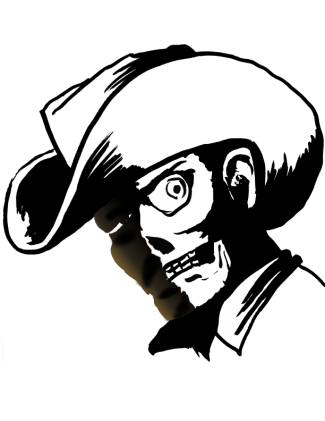Jason Campbell October 9, 2024 3 min read
By Jason Campbell
I’ve been running a weekly 5e campaign in Monte Cook’s Ptolus setting since January 2022, the player characters are currently 16th level. It can be difficult to run a 5e game with higher level characters while keeping the game challenging and the players engaged. This campaign diary series features notes from my players and I about the challenges of playing high level 5e.
Epic Battles and CR Values
The previous session ended with the PCs being “kidnapped” – teleported against their wills to a ship where 3 creatures waited for them, immediately attacking. This was designed to be a challenging, perhaps deadly, combat. I often use Mike Shea’s (aka Sly Flourish) Lazy Encounter benchmark. This says that for higher level PCs an encounter may be deadly if the sum total of monster CRs is more than half the sum of character levels.
The encounter featured three mask wights (CR 13, from Kobold Press’s Tome of Beasts volume I) and after 3 rounds, their leader, a shadow of death (CR 21, from Kobold Press’s Tome of Beasts volume II). The monster CRs total 60, compared to half of the PCs combined levels, which totals 40. That indicates a deadly battle. It’s also worth noting that creatures from the Kobold Press Tomes of Beasts tend to be stronger for their CR compared to monsters from the WotC books, which means that encounter would likely be quite deadly. For the past few levels it’s been predictably difficult to challege the heroes as they gain powerful spells and abilities, to the extent that in checking in with players some had noted they’d like to be challenged more in combat.

Reading the Stat Blocks
Encounter building formulae are helpful, but it doesn’t replace anticipating the effects of unique abilities. Two abilities were likely to cause problems for the players: The three mask wights each could wail (recharge 5-6) causing 65 points of thunder damage to those within 30′ (DC 17 charisma save for half). The shadow of death causes fright to those within 60′ (saving throw DC 22 wisdom), with those failing being paralized (immoble) for one minute. The mask wights could cast counterspell once per day, while the shadow of death had magic resistance.
The wail causes a lot of damage, and the fright can be worse, as each attack on a paralyzed creature is at advantage to hit, and counts as a critical hit when the attack succeeds. Most importantly, if the shadow of death reduces a PC to zero HP, that creature dies, without death saving throws and can only be brought back to life with a wish spell.
The Battle
The PCs had a tough battle in the first three rounds, doing heavy damage to one mask wight and banishing another. By the third round the last mask wight was nearly dead as the shadow of death arrived and attacked. The shadow did enough damage that a caster dropped concentration, bringing the banished mask wight back, while 2 PCs were paralyzed. The PC killed the final mask wight. One of the PCs who was paralyzed was dropped to zero HP by the shadow of death. A druid tried to heal the fallen PC, to no avail. At this point the PCs knew they might be in trouble and they retreated to the edge of the ship’s deck, taken their fallen comrade’s body with them. We left off here, so we’ll see next week if they continue the battle or retreat to safety.
Adjusting the Dials
When designing the encounter I made sure to allow some flexibility in the combat to maintain the difficulty level. In case the PCs had an easy time I could bring another mask wight into the fight when the shadow of death showed up. If there was danger of a total party kill, I decided that a group of mid-level NPCs the party had hired as assistants would show up and help. They aren’t strong enough combatants to defeat one of these creatures, but they could act as support.
Conclusion
The encounter was obviously quite challenging. If the PCs continue the fight next session I’ll have the NPCs show up as support and a bit of encouragement.
The shadow of death was modified a bit to fit the lore and the setting. A demigod of death will likely show up in the future, and pledging to this demigod is how the shadow of death got its power. I decided that although healing spells and revivify would have no effect against anyone killed by the shadow of death, raise dead or resurrection spells would work. In that case when they meet the demigod of death she’ll be bitter at them stealing a dead soul from her grasp.
The players were looking for more challenging encounters, so I think having one or two PCs die is not out of the question. The issue is whether having a wish spell be the only cure is fair. It could lead to a short quest for a high level wizard who could cast it, but meanwhile the player of that dead PC is not involved in the game. There’s also the idea that since this effect wasn’t foretold, it’s like pulling the rug out from under the players. They’ve entered combat with the understanding that resurrection might be possible if someone dies. Finding out afterwards that no expected spells will work doesn’t add to the tension of the battle and only serves to remove a player from the game for a time. A compromise of letting raise dead works seemed appropriate.
What do you think? have you run or played in an interlude session? How did it go? Let us know in the comments.







